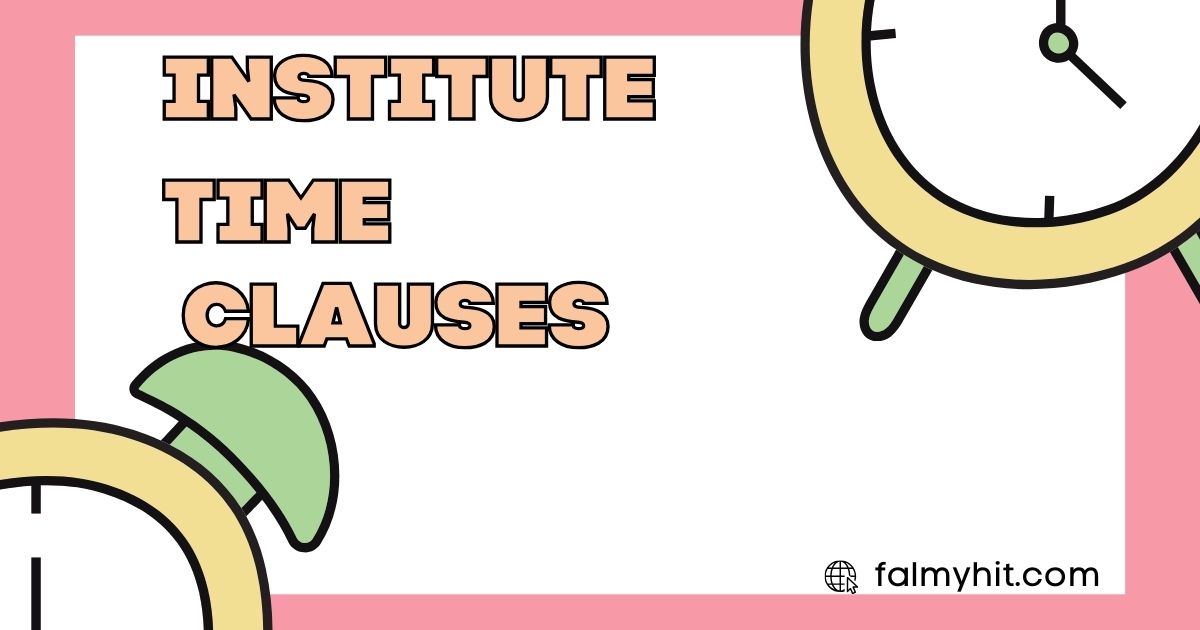Time clauses are an essential part of English grammar, providing clarity and context when describing events in relation to time. Among these, “institute time clauses” hold a unique significance, especially in academic and formal writing. This article will delve deeply into what institute time clauses are, their importance, and how to use them effectively.
What Are Institute Time Clauses?
Institute time clauses refer to specific time-related phrases or sentences that establish a clear timeframe for actions or events. These clauses are crucial in structured communication, often used to set schedules, timelines, or sequences in educational and institutional settings.
The Importance of Institute Time Clauses
Using institute time clauses ensures precision in communication. Whether you’re discussing deadlines, event schedules, or procedural guidelines, these clauses eliminate ambiguity and foster better understanding.
How to Identify Time Clauses
To identify an institute time clause, look for dependent clauses introduced by conjunctions like when, while, as soon as, or after. For example:
“The lecture will begin when the bell rings.”
Key Conjunctions Used in Institute Time Clauses
When: Indicates a specific point in time.
Example: “Students can leave the hall when the test ends.”
While: Describes simultaneous actions.
Example: “While the seminar was ongoing, attendees networked outside.”
After: Refers to actions occurring later.
Example: “The certificates will be distributed after the ceremony concludes.”
Before: Points to actions occurring earlier.
Example: “Submit your application before the deadline.”
As soon as: Highlights immediate succession.
Example: “The workshop will commence as soon as the projector is set up.”
Structuring Sentences with Institute Time Clauses
When constructing sentences with institute time clause, the placement of the clause matters:
At the beginning: “When the bell rings, the class will start.”
At the end: “The class will start when the bell rings.”
Both forms are grammatically correct, but the emphasis shifts based on the clause’s position.
Common Errors in Using Institute Time Clauses
Overusing conjunctions: Avoid redundancy, like “When the meeting will start when the clock strikes two.”
Mixing tenses incorrectly: Ensure the verb tenses in the time clause match the main clause logically.
Practical Applications in Academic Settings
Institute time clause are extensively used in academic and formal settings:
Class schedules: “The lecture will resume after the break.”
Examination instructions: “Do not write after the time is over.”
Meeting agendas: “Discuss the project as soon as the manager arrives.”
Real-Life Examples of Institute Time Clauses
“The library closes when the clock strikes 9 PM.”
“Students should return their books before the term ends.”
“The lab assistant will demonstrate the experiment after the equipment is set up.”
Tips for Mastering Institute Time Clauses
Understand the context: Identify whether the clause refers to past, present, or future events.
Practice sentence construction: Write examples using various conjunctions to enhance fluency.
Keep sentences concise: Avoid overly complex structures for clarity.
Institute Time Clauses in Formal Writing
In formal writing, institute time clause help maintain a professional tone. For instance:
“The research findings will be presented after all data is analyzed.”
This ensures clear communication of procedures and timelines.
Institute Time Clause in Conversations
In spoken English, time clauses are equally important for clear interaction:
“Let’s meet after the workshop ends.”
Difference Between Time Clauses and Conditional Clauses
While both use conjunctions, time clauses focus on when something happens, whereas conditional clauses address if something happens.
Time clause: “The students can leave when the clock strikes noon.”
Conditional clause: “The students can leave if the teacher allows it.”
Enhancing Your Writing with Institute Time Clauses
Using institute time clause effectively can make your writing more coherent and professional. They link ideas seamlessly and ensure your audience follows the timeline you’re presenting.
Institute Time Clauses in Academic Policies
Institutes frequently use time clauses in policies and guidelines. For example:
“Students must submit their assignments before the semester ends.”
This creates a sense of accountability and ensures deadlines are clear.
The Role of Punctuation in Institute Time Clauses
When a time clause begins a sentence, it is usually followed by a comma. For example:
“Before the exam starts, ensure your materials are ready.”
If the time clause comes later, a comma isn’t necessary:
“Ensure your materials are ready before the exam starts.”
Challenges in Learning Institute Time Clauses
For non-native speakers, mastering institute time clause can be challenging due to the variety of conjunctions and tenses involved. Practice and exposure are key to overcoming these challenges.
Conclusion
Institute time clause are indispensable for clear and structured communication, particularly in academic and formal settings. By understanding their function, mastering their use, and avoiding common pitfalls, you can enhance your writing and speaking skills.
FAQs
What is an institute time clause?
An institute time clause is a time-related phrase that specifies when an action occurs, often used in structured or formal communication.
How can I use institute time clauses effectively?
Use them with appropriate conjunctions like “when” or “before” and ensure they align with the main clause’s tense.
Are institute clauses only for formal writing?
No, they are used in both formal writing and everyday communication to clarify timelines.
What are common errors in institute time clause?
Errors include overusing conjunctions, mismatching tenses, or creating overly complex sentences.
Can institute time clause improve my writing?
Yes, they make your writing clearer, more organized, and professional, especially in academic and institutional contexts.

